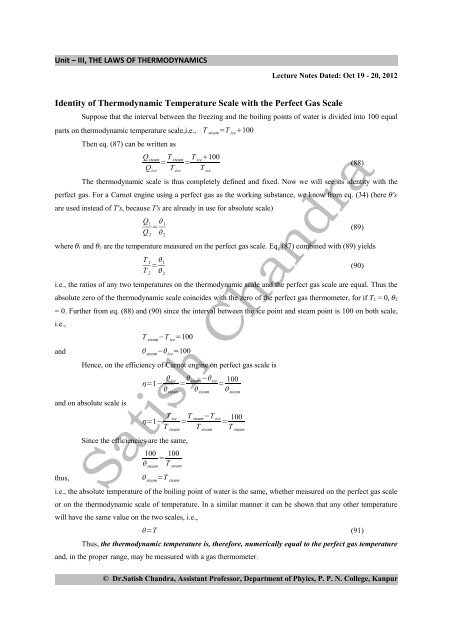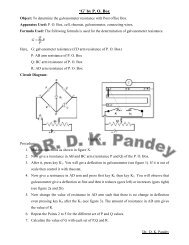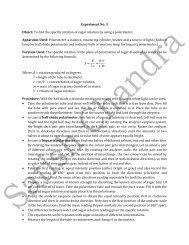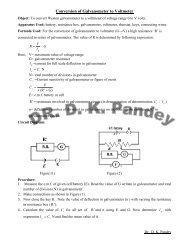Identity of Thermodynamic Temperature Scale with the Perfect Gas ...
Identity of Thermodynamic Temperature Scale with the Perfect Gas ...
Identity of Thermodynamic Temperature Scale with the Perfect Gas ...
You also want an ePaper? Increase the reach of your titles
YUMPU automatically turns print PDFs into web optimized ePapers that Google loves.
Unit – III, THE LAWS OF THERMODYNAMICS<br />
Lecture Notes Dated: Oct 19 - 20, 2012<br />
<strong>Identity</strong> <strong>of</strong> <strong>Thermodynamic</strong> <strong>Temperature</strong> <strong>Scale</strong> <strong>with</strong> <strong>the</strong> <strong>Perfect</strong> <strong>Gas</strong> <strong>Scale</strong><br />
Suppose that <strong>the</strong> interval between <strong>the</strong> freezing and <strong>the</strong> boiling points <strong>of</strong> water is divided into 100 equal<br />
parts on <strong>the</strong>rmodynamic temperature scale,i.e., T steam=T ice�100<br />
Then eq. (87) can be written as<br />
Q steam<br />
Qice = T steam<br />
= T ice�100 T ice<br />
T ice<br />
The <strong>the</strong>rmodynamic scale is thus completely defined and fixed. Now we will see its identity <strong>with</strong> <strong>the</strong><br />
perfect gas. For a Carnot engine using a perfect gas as <strong>the</strong> working substance, we know from eq. (34) (here q's<br />
are used instead <strong>of</strong> T's, because T's are already in use for absolute scale)<br />
Q1 Q2 = � 1<br />
� 2<br />
where q1 and q2 are <strong>the</strong> temperature measured on <strong>the</strong> perfect gas scale. Eq. (87) combined <strong>with</strong> (89) yields<br />
T 1<br />
T 2<br />
= � 1<br />
� 2<br />
i.e., <strong>the</strong> ratios <strong>of</strong> any two temperatures on <strong>the</strong> <strong>the</strong>rmodynamic scale and <strong>the</strong> perfect gas scale are equal. Thus <strong>the</strong><br />
absolute zero <strong>of</strong> <strong>the</strong> <strong>the</strong>rmodynamic scale coincides <strong>with</strong> <strong>the</strong> zero <strong>of</strong> <strong>the</strong> perfect gas <strong>the</strong>rmometer, for if T2 = 0, q2<br />
= 0. Fur<strong>the</strong>r from eq. (88) and (90) since <strong>the</strong> interval between <strong>the</strong> ice point and steam point is 100 on both scale,<br />
i.e.,<br />
T steam −T ice =100<br />
and � steam −� ice =100<br />
Hence, on <strong>the</strong> efficiency <strong>of</strong> Carnot engine on perfect gas scale is<br />
and on absolute scale is<br />
�=1− � ice<br />
� steam<br />
�=1− T ice<br />
T steam<br />
Since <strong>the</strong> efficiencies are <strong>the</strong> same,<br />
100<br />
= 100<br />
� steam<br />
T steam<br />
= �steam−�ice = 100<br />
� steam<br />
� steam<br />
= T steam−T ice<br />
= 100<br />
T steam<br />
T steam<br />
Satish Chandra<br />
thus, � steam =T steam<br />
i.e., <strong>the</strong> absolute temperature <strong>of</strong> <strong>the</strong> boiling point <strong>of</strong> water is <strong>the</strong> same, whe<strong>the</strong>r measured on <strong>the</strong> perfect gas scale<br />
or on <strong>the</strong> <strong>the</strong>rmodynamic scale <strong>of</strong> temperature. In a similar manner it can be shown that any o<strong>the</strong>r temperature<br />
will have <strong>the</strong> same value on <strong>the</strong> two scales, i.e.,<br />
(88)<br />
(89)<br />
(90)<br />
�=T (91)<br />
Thus, <strong>the</strong> <strong>the</strong>rmodynamic temperature is, <strong>the</strong>refore, numerically equal to <strong>the</strong> perfect gas temperature<br />
and, in <strong>the</strong> proper range, may be measured <strong>with</strong> a gas <strong>the</strong>rmometer.<br />
© Dr.Satish Chandra, Assistant Pr<strong>of</strong>essor, Department <strong>of</strong> Phyics, P. P. N. College, Kanpur
Unit – III, THE LAWS OF THERMODYNAMICS<br />
Absolute Zero<br />
To complete <strong>the</strong> definition <strong>of</strong> <strong>the</strong> <strong>the</strong>rmodynamic scale, we assign <strong>the</strong> arbitrary value <strong>of</strong> 273.16 o<br />
K to <strong>the</strong><br />
temperature <strong>of</strong> <strong>the</strong> triple point <strong>of</strong> water TTP. Thus<br />
T TP =273.16 o K<br />
For a Carnot engine operating between reservoirs at <strong>the</strong> temperatures T and TTP, we have<br />
Q<br />
Q TP<br />
= T<br />
T TP<br />
or, T =273.16 o K Q<br />
Q TP<br />
that <strong>the</strong> smaller <strong>the</strong> value <strong>of</strong> Q, <strong>the</strong> lower <strong>the</strong> corresponding T. The smallest possible value <strong>of</strong> Q is zero, and <strong>the</strong><br />
corresponding T is absolute zero. Thus, if a system undergoes a reversible iso<strong>the</strong>rmal process <strong>with</strong>out transfer<br />
<strong>of</strong> heat, <strong>the</strong> temperature at which this process takes place is called absolute zero. In o<strong>the</strong>r words, at absolute<br />
zero, an iso<strong>the</strong>rm and an adiabatic are identical.<br />
Since,<br />
A Carnot engine absorbing heat QH from a heat reservoir at TH and rejecting heat QL to a sink at TL.<br />
Q L<br />
Q H<br />
Then it has an efficiency<br />
= T L<br />
T H<br />
�=1− Q L<br />
=1− T L<br />
Q H<br />
T H<br />
For a Carnot engine to have an efficiency unity, it is clear that TL must be zero. When <strong>the</strong> sink is at<br />
absolute zero, all <strong>the</strong> heat from source QH will be converted into work by <strong>the</strong> Carnot engine, which is against <strong>the</strong><br />
second law. A heat engine <strong>with</strong> 100% efficiency is thus practically impossible.<br />
The TL cannot be less than zero, i.e., negative, for if it were so, QL would be negative which implies that<br />
<strong>the</strong> engine would be drawing heat both from <strong>the</strong> source and <strong>the</strong> sink. However, this contradicts <strong>the</strong> second law <strong>of</strong><br />
<strong>the</strong>rmodynamics. Therefore, we may conclude that <strong>the</strong>rmodynamic temperature <strong>of</strong> absolute zero or negative<br />
cannot be achieved by any mechanical means. That is, impossibility <strong>of</strong> attaining <strong>the</strong> absolute zero is implied<br />
by second law <strong>of</strong> <strong>the</strong>rmodynamics.<br />
The Third Law <strong>of</strong> <strong>Thermodynamic</strong>s<br />
To achieve progressively lower temperatures become more and more difficult. Essentially, it is a fact<br />
Satish Chandra<br />
that lower <strong>the</strong> temperature, less useful <strong>the</strong> heat is. This means that to attain absolute zero, an infinite number <strong>of</strong><br />
adiabatic demagnetisation operation will be needed. This observation is contained in <strong>the</strong> third law <strong>of</strong><br />
<strong>the</strong>rmodynamics:<br />
It is impossible to attain <strong>the</strong> absolute zero by a finite number <strong>of</strong> operations.<br />
Just like <strong>the</strong> second law, <strong>the</strong> third law has a number <strong>of</strong> equivalent statements. In <strong>the</strong> light <strong>of</strong> <strong>the</strong> first and<br />
second laws we can calculate entropy difference only, i.e., we cannot find <strong>the</strong> absolute value <strong>of</strong> entropy. This<br />
aspect is contained in <strong>the</strong> third law, which deals <strong>with</strong> <strong>the</strong> entropy <strong>of</strong> a system as its temperature tends to absolute<br />
zero.<br />
© Dr.Satish Chandra, Assistant Pr<strong>of</strong>essor, Department <strong>of</strong> Phyics, P. P. N. College, Kanpur<br />
(92)
Unit – III, THE LAWS OF THERMODYNAMICS<br />
It was discovered experimentally by Nernst. He observed that <strong>the</strong> net change in entropy <strong>of</strong> a system is<br />
very small, when <strong>the</strong>re is change from one low temperature equilibrium state to ano<strong>the</strong>r. For example, we may<br />
change liquid helium into solid helium by applying pressure or convert separate samples <strong>of</strong> sodium and chlorine<br />
at, say 4 o<br />
K into sodium chloride at <strong>the</strong> same temperature. This means that near absolute zero all systems are<br />
highly ordered and <strong>the</strong> entropy <strong>of</strong> all states (<strong>of</strong> every substances) is <strong>the</strong> same; in fact extremely small or<br />
essentially zero. Thus we may also state <strong>the</strong> third law <strong>of</strong> <strong>the</strong>rmodynamics as follows:<br />
The entropies <strong>of</strong> all systems and <strong>the</strong> entropy changes in all reversible iso<strong>the</strong>rmal process tend to zero<br />
as temperature approaches absolute zero.<br />
and,<br />
Ma<strong>the</strong>matically, we may write<br />
lim S �0 (93)<br />
T �0<br />
lim � S �0 (94)<br />
T �0<br />
Impossibility <strong>of</strong> Attaining <strong>the</strong> Absolute Zero<br />
Now we show that impossibility <strong>of</strong> attaining <strong>the</strong> absolute zero is equivalent to entropy tending to zero as<br />
T→ 0. Let us assume <strong>the</strong> contrary, so that we can operate a Carnot engine between two reservoirs, one<br />
maintained at absolute zero and <strong>the</strong> o<strong>the</strong>r at some finite temperature T, as in figure 18.<br />
Figure 18 T-S diagram <strong>of</strong> Carnot cycle operating between absolute zero and a finite temperature.<br />
For a cyclic process, we recall that<br />
� S=∮ �Q<br />
T =0<br />
But we can write, � S=� S 12�� S 23�� S 34�� S 41<br />
Satish Chandra<br />
<strong>with</strong>, � S 12 = Q<br />
T<br />
where Q is heat absorbed at temperature T. For an adiabatic process,<br />
� S 23 =� S 41 =0<br />
and by <strong>the</strong> third law � S 34=0<br />
Hence, dS=∮ �Q<br />
T =� S 12≠0<br />
But this contradicts <strong>the</strong> second law <strong>of</strong> <strong>the</strong>rmodynamics. This inconsistency demands that we cannot operate a<br />
Carnot engine using a single reservoir, i.e., it is not possible to attain absolute zero.<br />
© Dr.Satish Chandra, Assistant Pr<strong>of</strong>essor, Department <strong>of</strong> Phyics, P. P. N. College, Kanpur



![Ã
tkZ % laHkkouk;sa] mi;ksx vkSj laj{k.kA Energy : Explore, Harness ...](https://img.yumpu.com/49782265/1/190x245/atkz-lahkkouksa-miksx-vksj-lajkka-energy-explore-harness-.jpg?quality=85)


